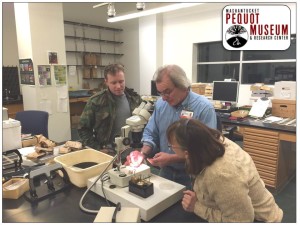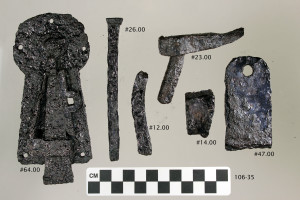Conservation
The conservation and identification process of battle-related artifacts is the single most defining factor of determining battlefield sites of the Pequot War.
Process
The most important aspect of archaeological fieldwork is quick turnaround in laboratory analysis. The identification of artifacts determine if they are battle-related (or in this case, at least from the 17th century), and greatly influence where to focus archaeological fieldwork efforts. Where should the archaeologists dig next?
Deciding where to dig is just like following a trail or a map – that hasn’t been cartographed yet (until the conservator can make well-documented identifications of battle-related or age-appropriate artifacts!).
Laboratory analysis involves 3 sequential steps:
Initial Examination, X-Radiography, & Conservation.
Initial artifact examination consists of cleaning the objects with a soft brush to examine with the naked eye and with a low-powered binocular microscope. Most of the time, age or identification of an artifact can not be determined from just the initial examination.
The next step is to take several x-radiographs (X-Rays) of the artifact with different exposures and from different angles and sides. X-Ray analysis is done as soon as possible so staff can quickly determine the age of the artifact and what it might be. X-Ray Analysis can capture many features on an artifact, such as drill holes and breaks, that cannot be detected in any other way, furthering its identification or age. For example, if the iron artifact is hand-wrought (generally 17th-18th century), in an X-Ray you would see a distinct “layering”, or strata, from being folded over so many times during its manufacture.
Standard conservation procedures are employed to clean the artifact to better discern its function (i.e. removing extraneous oxide from iron objects).





